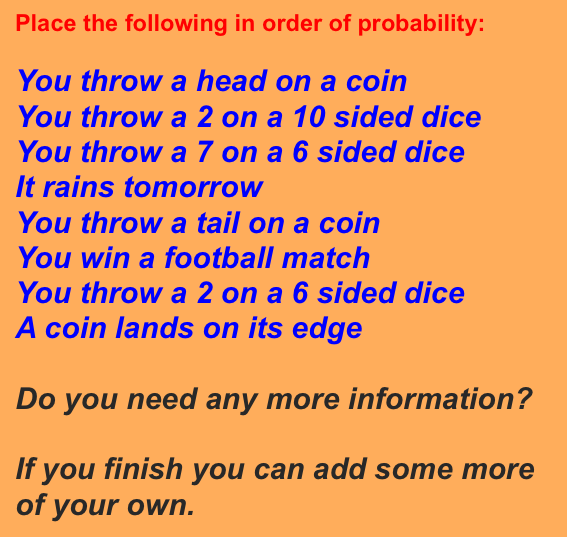Learning Target: To use probability to solve puzzles.
Success Criteria
Beginning
Beginning
To demonstrate calculating the probability of single events.
Developing
To demonstrate calculating the probability of two equally likely events happening at once.
Mastering
To investigation calculating the probability of multiple events.
To investigation calculating the probability of multiple events.
Resources
Beginning
Simple probability examples:
Stick on Maths - Probability (open in Keynote)
B5
B4
B5
Stick on Maths - Probabilities add to 1 (open in Keynote)
B6
Developing
D1
D2
CIMT: The Probability of Two Events (Sample Space Q1-5 and Tree Diagrams Q6-17)
D3Probability Spaces (from Ten Ticks, 6, 6, pages 38-9)*
D3
Mastering
M1
M2
M6
Question 1
A bag contains 3 black and 6 white counters. One counter is drawn and then replaced. A second counter is then drawn.
a) Draw a tree diagram to represent this, find the probability of each outcome.
b) What is the probability of:
i) Both counters being black;
ii) At least one white;
iii) one white and one black.
Question 2
A bag contains 3 black and 6 white counters. One counter is drawn but not replaced. A second counter is then drawn.
a) Draw a tree diagram to represent this, find the probability of each outcome.
b) What is the probability of:
i) Both counters being black;
ii) At least one white;
iii) one white and one black.
Question 3
A bag contains 7 black and 3 white counters. One counter is drawn but not replaced. A second counter is then drawn.
a) Draw a tree diagram to represent this, find the probability of each outcome.
b) What is the probability of:
i) Both counters being black;
ii) At least one white;
iii) one white and one black.
A bag contains 3 black and 6 white counters. One counter is drawn and then replaced. A second counter is then drawn.
a) Draw a tree diagram to represent this, find the probability of each outcome.
b) What is the probability of:
i) Both counters being black;
ii) At least one white;
iii) one white and one black.
Question 2
A bag contains 3 black and 6 white counters. One counter is drawn but not replaced. A second counter is then drawn.
a) Draw a tree diagram to represent this, find the probability of each outcome.
b) What is the probability of:
i) Both counters being black;
ii) At least one white;
iii) one white and one black.
Question 3
A bag contains 7 black and 3 white counters. One counter is drawn but not replaced. A second counter is then drawn.
a) Draw a tree diagram to represent this, find the probability of each outcome.
b) What is the probability of:
i) Both counters being black;
ii) At least one white;
iii) one white and one black.
CIMT: Estimating Number of Outcomes
Homework
A bag contains 5 red and 4 green counters. One counter is drawn but not replaced. A second counter is then drawn.
a) Draw a tree diagram to represent this, find the probability of each outcome.
b) What is the probability of:
i) Both counters being green;
ii) both counters are the same colour;
iii) one white and one black.
Upload a photo or our workings and answers to Showbie.
Homework
A bag contains 5 red and 4 green counters. One counter is drawn but not replaced. A second counter is then drawn.
a) Draw a tree diagram to represent this, find the probability of each outcome.
b) What is the probability of:
i) Both counters being green;
ii) both counters are the same colour;
iii) one white and one black.
Upload a photo or our workings and answers to Showbie.







